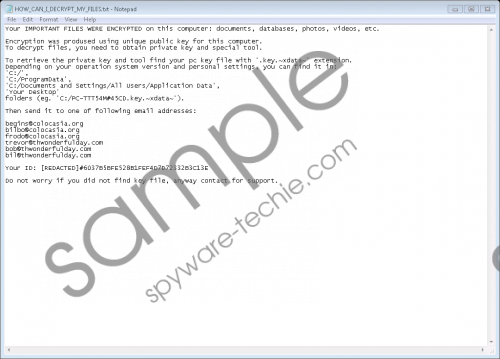Do you know what XData Ransomware is?
XData Ransomware is a malicious computer infection that was created to rip innocent users off. This program will attack you unawares, and it will hold your files hostage, demanding that you pay a ransom fee. Needless to say, you should not pay the fee because that would not solve anything. In fact, when you are infected with a ransomware program, it is very likely that you will have to delete your files along with the infection. It is a very grim perspective, but we have to choose what is best in this situation.
Our research team suggests that XData Ransomware was first released in the middle of May 2017. We cannot know for sure when exactly the program infected its first victim, but we know that the program spreads quite fast. Within 24 hours, it can affect around 150 systems, and its distribution method is still not clear. From what we have learned from previously released ransomware infections, we can assume that XData Ransomware probably employs spam email messages to spread around the web. Users are tricked into opening such messages because they often look like reports from financial institutions or other important documents sent from reliable sources.
Another possible way for XData Ransomware to enter your computer would be through a website exploit. This distribution method also seems pretty believable because the infection spreads mostly in the Ukraine. So it is possible that some website is used as a distribution source by the cyber criminals, and this website is mostly accessed by computer users in the Ukraine. Our data shows that the XData Ransomware infections in the country amount for 95% of the entire infection count, while there have also been a few reports from Germany, the United States, Estonia, and the Russian Federation.
Needless to say, even though the program may target specific regions, no one is safe when such dangerous applications are on the loose. Perhaps it is a bit of relief that XData Ransomware and other ransomware programs do not play hide and seek. You will know immediately that you have been infected with such a program. The infection process unfolds in the most common fashion. XData Ransomware screenshot
XData Ransomware screenshot
Scroll down for full removal instructions
When XData Ransomware enters your computer, it scans your system, looking for the files it can encrypt. Although the program does not encrypt all of your files, you can be sure that will affect your personal documents, and all the other files you use the most often. The program will use the AES encryption algorithm to lock your files, and the encrypted files will have the “.~xdata~” extension added to their filenames. Sometimes, when the infection is highly prevalent, security experts come up with a free decryption tool for it. Unfortunately, there is no free decryption tool for this program at the moment.
This means that to restore your files you would need to rely on a backup drive. That is, if you back up your files regularly in an external hard drive or someplace else. You might also be surprised to find that you have a lot of your files saved on other devices. For instance, we are sure that you can find quite a lot of your photos on your mobile devices. Also, your inbox should have most of your recent document files. Therefore, there is no need to panic when XData Ransomware enters your computer because there should always be a way to recover at least part of the encrypted data.
This program will make it sure that you know what it wants from you because it drops the ransom note in every folder that has encrypted files. The note does not say exactly how much you would have to pay for the decryption, but it gives you a list of email addresses you can use to contact the criminals.
Needless to say, you should never send anything to these people because there is no guarantee they would restore your locked files in the first place. Please follow the removal instructions you will find below this description to get rid of XData Ransomware for good. To be 100% sure you have terminated all the malicious files; scan your PC with the SpyHunter free scanner. You need to delete all the malicious threats to continue operating your system properly.
How to Delete XData Ransomware
- Remove the most recently opened executable file.
- Press Win+R and the Run prompt will open.
- Type %AppData% into the Open box and click OK.
- Remove the mssql.exe file.
- Search and remove the ransom note from all affected folders.
- Run a full PC scan with a licensed antispyware tool.
In non-techie terms:
XData Ransomware is a malicious infection that encrypts most of your frequently-used files. It then wants you to pay for the decryption key that would help you restore your files. It is never a good idea to do what cyber criminals ask you to, and giving your money away would not solve anything. Please remove XData Ransomware from your system immediately, and then take the appropriate measures that would ensure you avoid similar infections in the future.
